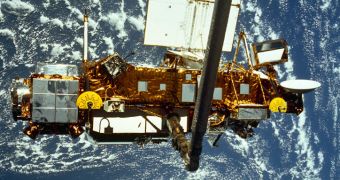Officials with the US Federal Emergency Management Agency (FEMA) say that they are currently making final preparations in advanced of a planned crash of an American out-of-control satellite.
The Upper Atmosphere Research Satellite (UARS) is currently in an unstable orbit, which makes it very difficult for orbital scientists to predict where exactly it will impact the ground. Still, FEMA operatives are getting ready for deployment wherever they will be demanded.
However, the emergency response crews will only be deployed if the UARS crashes of American soil. The satellite, weighing about 6,500 kilograms (14,330 pounds), may very well crash on other continents, or even in the ocean.
NASA officials' best estimate is that the spacecraft will make its fiery plunge through Earth's atmosphere on September 23, give or take a day. The uncertainty is caused by the fact that scientists don't know how the large vehicle will react as its atmospheric drag increases.
The American space agency calculated a 1-in-3,200 chance that anyone will be struck by debris from the burning, $750 million satellite. As it will plunge through the atmosphere, it will begin to burn up, disintegrating into smaller components that will spread over a large area.
NASA investigators have estimated that around 26 large pieces of debris will survive reentry. These components are made of titanium or other similar materials, which can all withstand temperature reaching thousands of degrees. Together, they will weigh about 532 kilograms (1,170 pounds).
It is estimated that the total area covered by debris will span more than 500 miles (804 kilometers) in length. “Look at how much of Earth is covered with water. There's a really good chance it's going to go straight into the ocean,” Victoria Samson explains.
She is the director of the Secure World Foundation Washington Office. The SWF is an organization whose purpose is to promote the peaceful use of low-Earth orbits, as well as deep space in general.
The space agency is also advising all citizens who may encounter potential pieces of the crashed satellite not to pick them up, or handle them themselves. “If you find something you think may be a piece of UARS, do not touch it. Contact a local law enforcement official for assistance,” the agency says.
FEMA agents will most likely be at hand in the affected areas moments after the crash. The agency has planned for such a contingency back in 2008, when it created its satellite reentry defense and response plans, Space reports.
“Obviously FEMA is always prepared to assist […] should any of these components land in the United States. It's, again, very, very unlikely when you look at the ratio of the land mass of the United States to the land mass of the world,” Nicholas Johnson explains.
“We have had intergovernmental meetings on this issue and I feel very confident that they will rise to the occasion should the occasion arise,” adds the official, who is the chief scientist of the NASA Orbital Debris Program, which is based at the NASA Johnson Space Center, in Houston, Texas.

 14 DAY TRIAL //
14 DAY TRIAL //